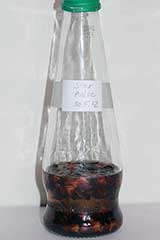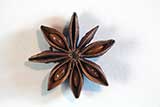Meats and Sausages
Herbal Infusions
Herbal infusions have been made with dry fruits, berries, roots, herbs and spices for hundreds of years. Our early medical science revolved around herbs and spices. They were the first remedies and ointments that the doctor prescribed to a patient, so it is not surprising that they still receive credit. Herbal infusion may be produced from a particular herb or spice, for example cinnamon or cloves, or by mixing different ingredients. For example in 1510 the Benedictine monk, Dom Bernardo Vincelli, created a secret elixir that is still sold today. Bénédictine contains 27 different plants and spices and the recipe is a closely guarded trade secret, known to only three people at any given time.
The flavor compounds from herbs and spices can be extracted by maceration. You can produce an extract from cloves, cinnamon, citrus skins, grass or their blends. The processing method remains basically the same as for dry fruit. The basic steps:
- Material preparation. The material is cut, ground, smashed to about 1-2 cm (¼-½ ") particles. Discard the pectin rich white pith of citrus skins.
- Macerating with alcohol. From 3 to 10 liters of alcohol is applied to 1 kg of herb/spice material. An average amount may be 1 part herb to 5 parts alcohol. Dry materials are macerated from 3-21 days with 40-60% alcohol.
- Filtering. This is accomplished pouring off the liquid or filtering through a cloth.
Most aromatic herbs and spices owe their aroma to oil compounds they contain. Those oils will dilute easily in strong alcohol, but may come out of solution and become cloudy when the liquid is watered down. On the other hand using weak alcohol will mainly extract substances that dilute easily in water. Such substances contain less aromatic flavors but more acids. The liquid's flavor moves towards the acidic, bitter and sour ends of the scale.
Herbal infusions are manufactured by four methods:
- Cold extraction.
- Hot extraction.
- Percolation.
- Distillation.
Larger materials, such as cinnamon tree bark or whole nutmeg are usually broken down to 1-2 cm size. Long grass, for example bison grass, is cut to 10 cm length. Leaves such as tea or rose petals may be left intact. The process follows the same steps for making infusions. Material is covered with alcohol and the container is closed tight. The choice of alcohol follows the general guidelines and is related to the amount of water the material contains.
1.Cold extraction
General Guidelines for Making Herbal Infusions
| Material | Alcohol Strength | Time | Notes |
|---|---|---|---|
| Fresh citrus skins | 75-80%, Single immersion only | 3-4 days | Longer times introduce bitterness even if the white pith has been removed. |
| Dry herbs, dry citrus skins (Single immersion) | 50% Single immersion | 2-3 weeks | Follow the usual standard procedure, see dry fruit immersion. Stir once a day. |
| Dry herbs, dry citrus skins (Double immersion) | 40% Double immersion | 2-3 weeks | Follow with double infusion if you want to maximize the amount of infusion, especially when expensive spice like vanilla is used. Then combine infusions together. |
3-10 times more alcohol is added in relation to the weight of material e.g. 3-10 liter per 1 kg material.
It should be noted that pure alcohol dissolves oil but not water so the alcohol strength will influence the type of components the herb will release best:
- High strength alcohol - aromatic oils, fats, resins.
- Low strength alcohol - colorants, bitter compounds, acids, sugars.
Pure alcohol may extract and dissolve oils which may come out from the solution when the infusion is later diluted. This may create cloudiness which is not easy to filter. Such an occurrence will be alarming for commercial producers, but not for hobbyists.
To summarize, manipulating alcohol strength provides a certain degree of control over the quality of an herbal infusion. Dry herbs and spices absorb up to 40% of alcohol. To obtain 200 ml of infusion from 20 g of dry herbs we have to add 325 ml of 50% alcohol. Herbs and spices are costlier than fruit, so It should be noted that pure alcohol dissolves oil but not water so the alcohol strength will influence the type of components the herb will release best:
- High strength alcohol - aromatic oils, fats, resins.
- Low strength alcohol - colorants, bitter compounds, acids, sugars.
It is recommended to go with the second immersion method. Add 200 ml for the first immersion, siphon the infusion out, and then add the remaining 125 ml of alcohol. Siphon out and combine both infusions. They should amount to 200 ml total. As 20 g of herbs were used, 1 g corresponds to 10 ml of infusion. Store in a dark glass jar.
2. Hot extraction. The advantage of this method is that it shortens the time of osmosis or diffusion which takes place at a faster rate at higher temperatures. Because alcohol evaporation may create losses and safety hazards, this methods requires expensive professional equipment. The process takes place at 50-60° C, and 40-60% alcohol is added at 2-5 times the weight of material e.g. 2-5 liter of alcohol per 1 kg material. This is a one stage immersion process lasting from 4-12 hours.



















